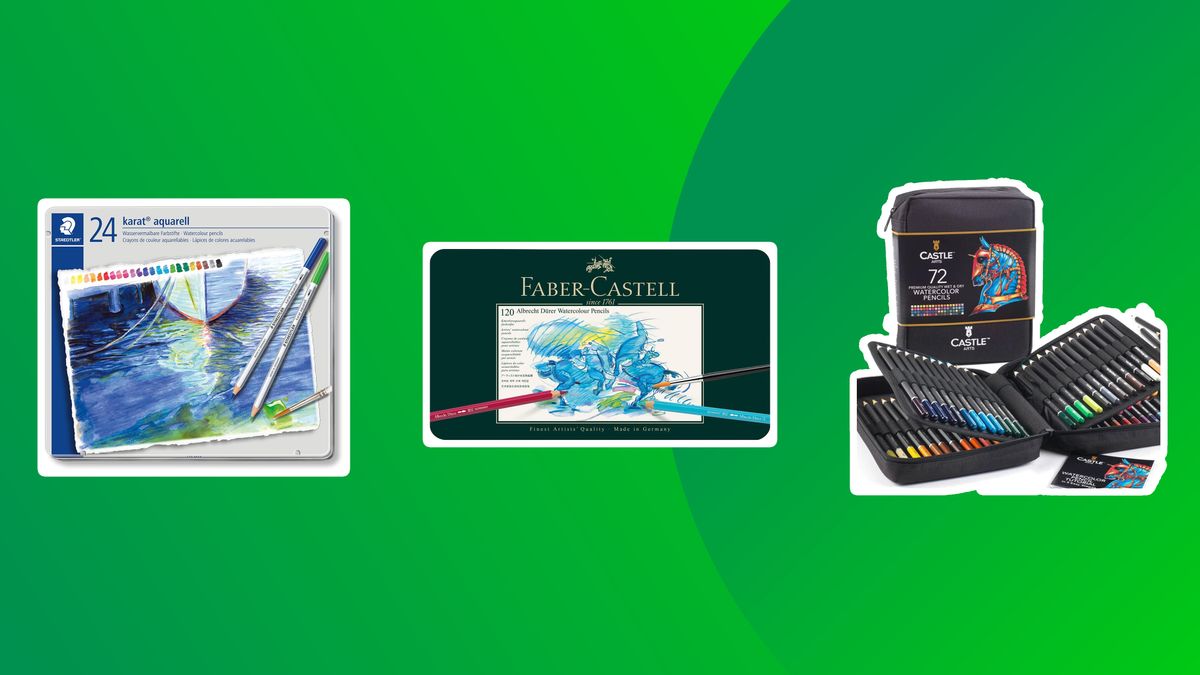The best watercolour pencils open up a whole new way of creating art. You draw as you would with a normal pencil, then brush over your drawings with water to produce intricate, beautiful wash effects. Best of all, you can take them anywhere without the risk of mess that comes with even the best watercolour paints.
Not all watercolour pencils are made equally, since there can be big variations in how smoothly they blend, whether they dry permanent and how they perform in wet and dry use. We’ve tested a wide range of brands to find the best options for different needs, from beginner watercolour pencils to options for pros and even for kids. In drawing up this list, I’ve stuck to only those that lay down well, blend easily, hold comfortably and hold up well to regular usage. I’ve also considered the value and colour range offered in each set.
Pencils are just one part of the equation, of course. You’ll need thick enough paper to stand the volume of liquid, so make sure to check out our guide to the best watercolour paper. If you’re looking for other supplies as well as watercolour pencils, see our guides to the best coloured pencils and the best mechanical pencils.
The best watercolour pencils
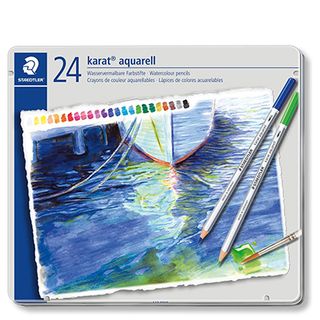 Best overall
Best overall
1. Staedtler Karat Aquarell
+ Break-resistant
+ High pigment
+ Comfortable
– No extras
These pencils are expertly crafted, lay down beautifully, and blend and wash easily. There’s a good range of colours (available in sets of 12, 24, 36, 48 and 60) and brighter hues really stand out, even when mixed. Their 3mm, high-pigment leads are resistant to breakage and sharpen easily.
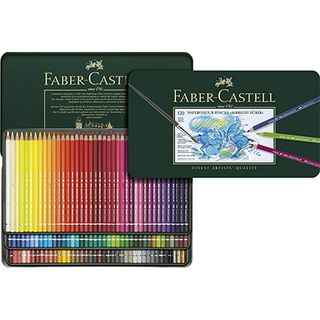 Best premium
Best premium
2. Faber-Castell Albrecht Durer
+ High-quality
+ Fade-resistant
– Overkill for beginners
Coming in sets of 12, 24, 60 and 120, these pencils provide sharp, fine lines and offer excellent point retention and rich, beautifully blendable colours. We found the 3.8mm leads to be super-strong, secured with a proprietary secural bonding process. They’re great for all kinds of art, and you get a 10mm brush thrown in.
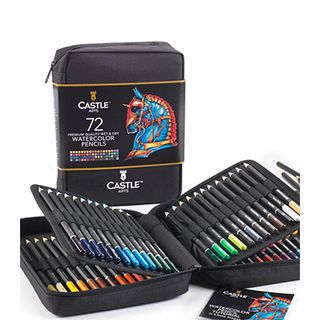 Best value
Best value
3. Castle Art 72 Pencils Set
+ Break-resistant
+ Good depth
+ Lots of pencils
– Varied blending
These are also great for beginners. They offer a great range of colours for the price and come with a short tutorial as well as a zip bag. They perform well, and can be used wet-on-wet, wet-on-dry, and wet and dry; though we have found some variation in how well they take water.
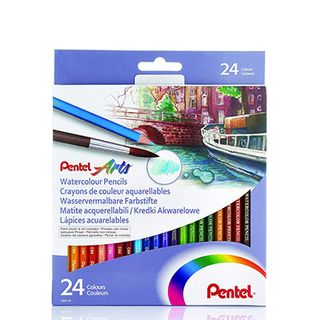 Beginner
Beginner
4. Pentel Arts Watercolour Pencils
+ Blend gently
+ Great value
– Hard to get to a sharp point
We think this pack from Pentel makes an excellent starter kit or Christmas present, containing 24 professional-grade pencils. We found that the pencils apply colour evenly and smoothly, and they are affected by water in a consistent way, blending nice and smoothly.
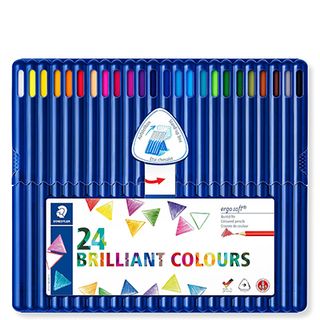 For kids
For kids
5. Staedtler Ergosoft Aquarell
+ Break-resistant
+ Easy to hold
– Difficult to sharpen
We recommend these watercolour pencils for children. The triangular shape and non-slip grips making them comfortable to hold (although not very easy to sharpen). Like all Staedtler watercolour pencils, they’re resistant to breakage, and the soft 3mm leads produce vibrant colours.
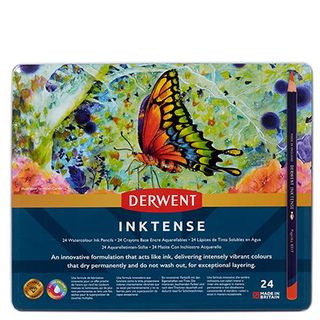 Best intensity
Best intensity
+ Intense colours
+ Good for layering
– Wet use only
These pencils can help you create vivid colours, but once your layer has dried, it’s permanent, meaning more colour can be added on top without affecting the layer underneath. These Inktense pencils produce a vivid, ink-like color when combined with water. Note, when these pencils are used dry, they’re rather dull.
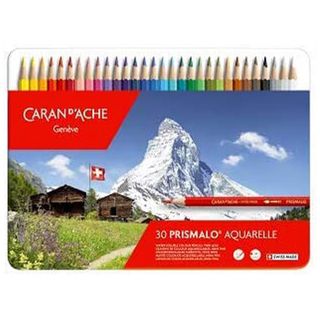 Best detail
Best detail
7. Caran D’ache Prismalo Aquarelle
+ Sharpen to a point
+ Colours mix well
– Designed for pro artists
If you’re wanting to create intricate details, these small 3mm lead pencils can be sharpened to a fine point. They’re pricey, but lovely to hold and use, and the vivid colours are easy to control, mixing beautifully. If you’re experienced, we’d recommend them. They’re available in sets of 12, 30, 40, and 80.
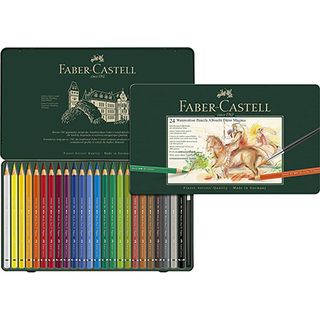 For large pieces
For large pieces
8. Faber-Castell Albrecht Durer Magnus
+ Soft laydown
+ Brush included
– Limited range
If you like working on a big canvas, then these big, fat, vibrant pencils could be just what you’re looking for. We found the 5.3mm leads allowed us to cover large areas quickly and easily, and their size and shape make them easier on the wrist too. They are available in tins of 12 or 24, and come with a 10mm paintbrush included.
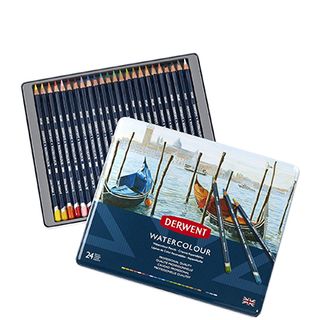 Mid-range
Mid-range
9. Derwent Watercolour Pencils
+ Soft and light colours
+ Wax dissolves easily
– Dries very quickly
These are a little cheaper, but still perform well. They use quality water-soluble pigments in a 3.4mm lead, and you won’t be short of colours, barring more vibrant hues. They dry quickly, so you’ll have to keep applying fresh colour and water. They are sold in sets of 12, 24, 36, 48 and 72.
FAQs
How do watercolour pencils work?
While a normal colour pencil secures the pigment in a wax- or oil-based binder, a watercolour pencil has a water-soluble binder. That means if you add water, the pigment will dissolve in it, giving you a watercolour paint wash that you can spread around the paper. If you don’t add water, though, you can just use it as a normal pencil.
How do you use watercolour pencils?
Watercolour pencils are used to make a watercolour wash. There are a range of techniques you can employ. One is to first make your marks just as you would with a normal coloured pencil. Then apply a damp paintbrush or sponge to intensify and spread the colours around the paper.
This technique is great for combining detailed lines with softer, watercolour strokes. You might use it, for example, when detailing specific flora and fauna in a nature scene. It can also be used to blend colours together.
Another approach is to dip the tip of your watercolour pencil into the water before making your marks. This will result in vibrant, free flowing lines, and make a particular colour really stand out on the paper.
The best watercolour pencils are actually very versatile. You can use them dry on paper like a normal pencil for details and fine lines. And if you’re using them wet, you can use them dipped in water for a flowing effect and bold colours, apply them on wet paper for blurs, colour fades and washes, or you can dissolve them in water than then brush them on saving you from reaching for your paints. Of course you can also combine them with watercolour paints.
Can you use watercolour pencils normally?
Yes, you can use watercolor pencils dry, just like you would a normal coloured pencil. In this case, the marks you make won’t differ from using the latter at all. It does, however, give you the option to apply water to those marks later and create a watercolour wash… but you don’t have to.
What are the benefits of using the best watercolour pencils?
The big benefit of watercolour pencils over paints is that you can take them anywhere you go with a lot less mess. Pack some good watercolour paper and your pencils, and you have a very portable little workshop which you can set up almost instantly to start work whenever inspiration strikes.
What kind of paper do you need for watercolour pencils?
When you’re using watercolour pencils, it’s advisable to use something that’s a little thicker than regular paper, which will warp when you add water to it. The best choice is to use specialist watercolour papers.
Specialist watercolour paper is better than normal paper for watercolour drawing and painting. That’s because it’s thicker than normal sketching paper and coated with a special treatment, so it won’t absorb water too quickly. This means you won’t have to rush your artwork, and will have more time to get it right.
Watercolour papers are typically 140lb (300gsm), 200lb (425gsm) and 300lb (638gsm). The heavier the paper, the more water can be applied.
What’s the best watercolour paper?
There are three standard types of machine-produced watercolour paper on the mass market. The smoothest surface is hot pressed (HP) watercolour paper. Cold pressed (CP) watercolour paper offers a slightly raised surface. Finally, rough watercolour paper has a textured surface. If you want to paint fine detail, hot pressed is best, while rough paper is better for atmospheric creations, and cold pressed sits between the two for more general artwork. We’d recommend starting with Arches Watercolor Paper or Savoir Faire Studio Watercolor Pad, or see our best watercolour paper guide for more options.
How do you sharpen watercolour pencils?
Because the leads of watercolour pencils are soft, it can be a challenge to sharpen them without the leads breaking. For that reason, you should avoid electric pencil sharpeners, and low quality manual pencil sharpeners. Use the best pencil sharpener you can afford, place the pencil in the biggest hole if there are two, and always twist the sharpener rather than the pencil. Alternatively, use a sharp knife or scalpel.
How to choose the best watercolour pencils
There are several things to consider when it comes to choosing a watercolour pencil. First, there’s the thickness of the lead. Thinner leads are better for fine detailed work, while thicker leads will help you cover more area quickly. Then there’s the shape of the pencil: will a round, hexagonal pencil or triangular pencil sit more comfortably in your hand?
Another consideration is the number of pencils in the set. Do you need a big set with the widest spectrum of colours possible, or do you plan to do a lot of blending, which means a smaller set may do?
Finally, you should consider how tough you need your pencil to be. If you tend to break a lot of leads, you might want to opt for a brand that prides itself on the toughness and durability of its leads.
How we test the best watercolour pencils
We test watercolour pencils by drawing with them on different paper surfaces to evaluate their compatibility and responsiveness. We keep a close eye on their water solubility and the level control each pencil affords, ensuring that the pigments disperse evenly without leaving streaks or undesirable textures. We also consider pencils’ build quality, ease of sharpening, resistance to breakage, pigment intensity, colour vibrancy, blendability and lightfastness.
 Best overall
Best overall Best premium
Best premium Best value
Best value Beginner
Beginner For kids
For kids Best intensity
Best intensity Best detail
Best detail For large pieces
For large pieces Mid-range
Mid-range